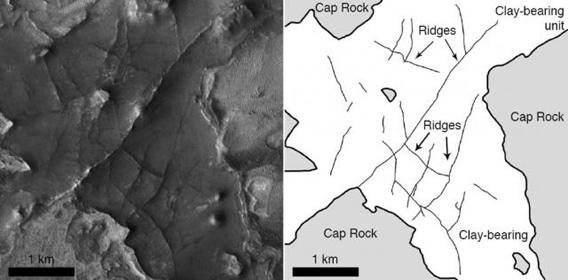Mars is cold, dry, and apparently dead. But it wasn’t always this way. I’ve written before about the evidence of past liquid water on Mars; there are copious data to support the idea that there were rivers, lakes, catastrophic floods, and even oceans on the red planet’s surface long ago.
New observations have turned up yet more evidence of this, in a way I wouldn’t have expected. A winding network of raised ridges indicate that water once flowed under the surface of Mars. This threw me for a moment: I’d expect gullies, arroyos, and valleys to indicate flowing water. How can raised ridges support this idea?
You have to think of this as a two step process: First, the way these features formed, and then second, what’s happened since.
In this case, scientists used the fantastic HiRISE camera on the Mars Reconnaissance Orbiter to look at two regions of Mars where these ridges are present. Here’s an exaggerated three-dimensional representation made using images and elevation data:

Image credit: NASA Mars Reconnaissance Orbiter
You can see the ridges running in various directions across the rock (the thicker, overlapping wormy-looking things are actually sand dunes, blown by the wind into lower-lying regions).
Scientists think these ridges were originally cracks in the crater floor, formed by the enormous stresses the surface underwent during the impact that formed the crater itself. Liquid, probably from beneath the surface, would have subsequently flowed into these cracks, filling them. If the liquid were water, it would have deposited minerals (like water can in your sink) that would form a very hard material. Over eons, the softer rocks around the mineral-filled cracks would erode away, leaving the much harder material in the cracks behind. You’re left with ridges—structures that now have positive elevation, but which started as cracks, structures with negative elevation. Cool.
However, there’s a caveat. Lava used to flow on Mars as well. How do we know these ridges aren’t volcanic in original instead of hydrologic?

Image credit: NASA Mars Reconnaissance Orbiter
There are two lines of evidence pointing that way. One is that the region surrounding the ridges is loaded with clay, a mineral thought to form only in water. In fact, the ridges only appear where this clay is present, indicating an actual connection. Second, the ridges themselves don’t appear to align well with any volcanic events on Mars. Their orientation matches the overall crater orientation, which means they formed from the impact stresses, and not large-scale volcanism. Both pieces of evidence are circumstantial, but compelling.
The way to know for sure is to find out the chemical composition of those ridges. That’s hard to do from orbit on such a small scale; the ridges are hundreds of meters long but only a few meters wide. The best bet is to land a probe there and poke at them. That may not happen any time soon, so until then we’ll have to file this under the very-cool-and-interesting-but-we’ll-have-to-wait-for-solid-proof category.
At this point, though, one thing we’re sure about is the presence of lots of water on Mars. A lot of it is still there in the form of ice in the polar caps and under the surface at mid- to high latitudes. It seems clear it once flowed on and under the surface as well. It really makes me wonder if water could flow under the surface even today. It’s unlikely; you need a heat source, and Mars looks pretty lean in that category these days. Still, Mars is a surprising place, and no doubt has plenty of surprises left for us to find.
[Bonus: While reading about this, I learned a new word: anastomose, which means to join together again, like two streams that split upstream coming back together downstream. That one’s going right into my sciencey thesaurus.]
